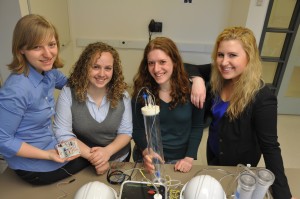
Woods Hole Oceanographic Institution Team: Katherine Mackenzie, Sarah Pedicini, Salome Stulberg, Courtney Murphy
2010-2011: In collaboration with Woods Hole Oceanographic Institution (WHOI), this student team designed an autonomous sparging chamber subsystem as part of a larger system to measure water concentrations of radon in deep sea conditions. The goal of the initiative is to track submarine groundwater discharge (for which radon is a naturally occurring geochemical tracer) and study its impacts on ocean ecosystems.
The sparging chamber moves radon from water to air to the radon detecting units in the overall system. The Smith team constructed a sparging chamber prototype that bubbles air through water and sprays air through the headspace in the chamber. The team designed and built a system of sensors, valves, and a microcontroller to regulate air and water flow through the chamber and measure temperature, pressure, and humidity in the headspace. The team designed the subsystem to be used up to 200m underwater and to be deployable from an autonomous underwater vehicle. After validating the components individually, the team tested their whole system, submersed, in a laboratory.
The team provided their WHOI liaisons with CAD drawings of the sparging chamber, microcontroller code and sequencing explanation, and a user manual for integrating the sparging chamber into the overall system. Next steps include pier-side testing followed by deep-sea implementation.
